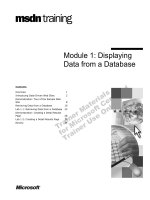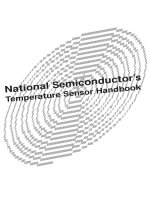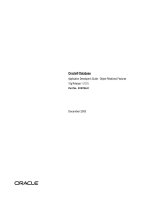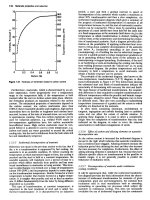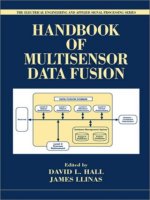Tài liệu Aeronautical Engineer’s Data Book Clifford Matthews doc
Bạn đang xem bản rút gọn của tài liệu. Xem và tải ngay bản đầy đủ của tài liệu tại đây (2.26 MB, 281 trang )
Aeronautical
Engineer’s
Data Book
Clifford Matthews BSc, CEng, MBA, FIMechE
OXFORD AUCKLAND BOSTON JOHANNESBURG
MELBOURNE NEW DELHI
Butterworth-Heineman
Linacre House, Jordan Hill, Oxford OX2 8DP
225 Wildwood Avenue, Woburn, MA 01801-2041
A division of Reed Educational and Professional Publishing Ltd
A member of the Reed Elsevier plc group
First published 2002
© Clifford Matthews 2002
All rights reserved. No part of this publication
may be reproduced in any material form (including
photocopying or storing in any medium by electronic
means and whether or not transiently or incidentally
to some other use of this publication) without the
written permission of the copyright holder except
in accordance with the provisions of the Copyright,
Designs and Patents Act 1988 or under the terms of a
licence issued by the Copyright Licensing Agency Ltd,
90 Tottenham Court Road, London, England W1P 9HE.
Applications for the copyright holder’s written permission
to reproduce any part of this publication should be addressed
to the publishers
British Library Cataloguing in Publication Data
Matthews, Clifford
Aeronautical engineer’s data book
1. Aerospace engineering–Handbooks, manuals, etc.
I. Title
629.1’3
Library of Congress Cataloguing in Publication Data
Matthews, Clifford.
Aeronautical engineer’s data book / Clifford Matthews.
p. cm.
Includes index.
ISBN 0 7506 5125 3
1. Aeronautics–Handbooks, Manuals, etc. I. Title.
TL570.M34 2001
629.13'002'12–dc21 2001037429
ISBN 0 7506 5125 3
Composition by Scribe Design, Gillingham, Kent, UK
Printed and bound by A. Rowe Ltd,
Chippenham and Reading, UK
Contents
Acknowledgements vii
Preface ix
Disclaimer x
1 Important Regulations and Directives 1
2 Fundamental Dimensions and Units 6
2.1 The Greek alphabet 6
2.2 Units systems 7
2.3 Conversions 8
2.4 Consistency of units 20
2.5 Foolproof conversions: using unity
brackets 21
2.6 Imperial–metric conversions 22
2.7 Dimensional analysis 22
2.8 Essential mathematics 25
2.9 Useful references and standards 47
3 Symbols and Notations 49
3.1 Parameters and constants 49
3.2 Weights of gases 49
3.3 Densities of liquids at 0°C 50
3.4 Notation: aerodynamics and fluid
mechanics
50
3.5 The International Standard
Atmosphere (ISA)
56
4 Aeronautical Definitions 66
4.1 Forces and moments 66
4.2 Basic aircraft terminology 70
4.3 Helicopter terminology 71
4.4 Common aviation terms 72
4.5 Airspace terms 75
5 Basic Fluid Mechanics 76
5.1 Basic properties 76
5.2 Flow equations 79
iv Contents
5.3 Flow regimes 86
5.4 Boundary layers 88
5.5 Isentropic flow 89
5.6 Compressible 1D flow 90
5.7 Normal shock waves 91
5.8 Axisymmetric flow 93
5.9 Drag coefficients 94
6 Basic Aerodynamics 96
6.1 General airfoil theory 96
6.2 Airfoil coefficients 96
6.3 Pressure distributions 98
6.4 Aerodynamic centre 100
6.5 Centre of pressure 101
6.6 Supersonic conditions 102
6.7 Wing loading: semi-ellipse
assumption
103
7 Principles of Flight Dynamics 106
7.1 Flight dynamics – conceptual
breakdown
106
7.2 Axes notation 106
7.3 The generalized force equations 110
7.4 The generalized moment equations 110
7.5 Non-linear equations of motion 111
7.6 The linearized equations of motion 111
7.7 Stability 114
8 Principles of Propulsion 115
8.1 Propellers 115
8.3 Engine data lists 126
8.4 Aero engine terminology 126
8.5 Power ratings 129
9 Aircraft Performance 132
8.2 The gas turbine engine: general
principles 118
9.1 Aircraft roles and operational profile 132
9.2 Aircraft range and endurance 136
9.3 Aircraft design studies 138
9.4 Aircraft noise 140
9.5 Aircraft emissions 144
10 Aircraft Design and Construction 145
10.1 Basic design configuration 145
10.2 Materials of construction 164
10.3 Helicopter design 165
10.4 Helicopter design studies 168
v Contents
11 Airport Design and Compatibility 173
11.1 Basics of airport design 173
11.2 Runway pavements 196
11.3 Airport traffic data 197
11.4 FAA-AAS airport documents 197
11.5 Worldwide airport geographical data 205
11.6 Airport reference sources and
bibliography 205
12 Basic Mechanical Design 215
12.1 Engineering abbreviations 215
12.2 Preferred numbers and preferred sizes 215
12.3 Datums and tolerances – principles 217
12.4 Toleranced dimensions 218
12.5 Limits and fits 223
12.6 Surface finish 227
12.7 Computer aided engineering 224
13 Reference Sources 235
13.1 Websites 235
13.2 Fluid mechanics and aerodynamics 235
13.3 Manufacturing/materials/structures 235
13.4 Aircraft sizing/multidisciplinary design 240
13.5 Helicopter technology 240
13.6 Flying wings 240
13.7 Noise 241
13.8 Landing gear 241
13.9 Airport operations 241
13.10Propulsion 242
Appendix 1 Aerodynamic stability and control
derivatives 243
Appendix 2 Aircraft response transfer
functions 245
Appendix 3 Approximate expressions for
dimensionless aerodynamic
stability and control derivatives 247
Appendix 4 Compressible flow tables 253
Appendix 5 Shock wave data 261
Index 269
Preface
The objective of this Aeronautical Engineer’s
Data book is to provide a concise and useful
source of up-to-date information for the
student or practising aeronautical engineer.
Despite the proliferation of specialized infor-
mation sources, there is still a need for basic
data on established engineering rules, conver-
sions, modern aircraft and engines to be avail-
able in an easily assimilated format.
An aeronautical engineer cannot afford to
ignore the importance of engineering data and
rules. Basic theoretical principles underlie the
design of all the hardware of aeronautics. The
practical processes of fluid mechanics, aircraft
design, material choice, and basic engineering
design form the foundation of the subject.
Technical standards, directives and regulations
are also important – they represent accumu-
lated knowledge and form invaluable guide-
lines for the industry.
The purpose of the book is to provide a
basic set of technical data that you will find
useful. It is divided into 13 sections, each
containing specific ‘discipline’ information.
Units and conversions are covered in Section
2; a mixture of metric and imperial units are
still in use in the aeronautical industry. Infor-
mation on FAA regulations is summarized in
Section 1 – these develop rapidly and affect us
all. The book contains cross-references to
other standards systems and data sources. You
will find these essential if you need to find
more detailed information on a particular
subject. There is always a limit to the amount
viii Preface
of information that you can carry with you –
the secret is knowing where to look for the
rest.
More and more engineering information is
now available in electronic form and many
engineering students now use the Internet as
their first source of reference information for
technical information. This new Aeronautical
Engineer’s Data Book contains details of a
wide range of engineering-related websites,
including general ‘gateway’ sites such as the
Edinburgh Engineering Virtual Library
(EEVL) which contains links to tens of
thousands of others containing technical infor-
mation, product/company data and aeronauti-
cal-related technical journals and newsgroups.
You will find various pages in the book
contain ‘quick guidelines’ and ‘rules of thumb’.
Don’t expect these all to have robust theoret-
ical backing – they are included simply
because I have found that they work. I have
tried to make this book a practical source of
aeronautics-related technical information that
you can use in the day-to-day activities of an
aeronautical career.
Finally, it is important that the content of
this data book continues to reflect the infor-
mation that is needed and used by student and
experienced engineers. If you have any sugges-
tions for future content (or indeed observations
or comment on the existing content) please
submit them to me at the following e-mail
address:
Clifford Matthews
Acknowledgements
Special thanks are due to Stephanie Evans,
Sarah Pask and John King for their excellent
work in typing and proof reading this book.
Disclaimer
This book is intended to assist engineers and
designers in understanding and fulfilling their
obligations and responsibilities. All interpreta-
tion contained in this publication – concerning
technical, regulatory and design information
and data, unless specifically otherwise identi-
fied, carries no authority. The information
given here is not intended to be used for the
design, manufacture, repair, inspection or
certification of aircraft systems and equipment,
whether or not that equipment is subject to
design codes and statutory requirements.
Engineers and designers dealing with aircraft
design and manufacture should not use the
information in this book to demonstrate
compliance with any code, standard or regula-
tory requirement. While great care has been
taken in the preparation of this publication,
neither the author nor the publishers do
warrant, guarantee, or make any representa-
tion regarding the use of this publication in
terms of correctness, accuracy, reliability,
currentness, comprehensiveness, or otherwise.
Neither the publisher, author, nor anyone, nor
anybody who has been involved in the
creation, production, or delivery of this
product shall be liable for any direct, indirect,
consequential, or incidental damages arising
from its use.
Section 1
Important regulations and
directives
A fundamental body of information is
contained in the US Federal Aviation Regula-
tions (FAR). A general index is shown below:
Federal Aviation Regulations
Chapters I and III
Subchapter A – definitions and
abbreviations
Part 1: Definitions and abbreviations
Subchapter B – procedural rules
Part 11: General rule-making procedures
Part 13: Investigative and enforcement
procedures
Part 14: Rules implementing the Equal
Access to Justice Act of 1980
Part 15: Administrative claims under
Federal Tort Claims Act
Part 16: Rules of practice for federally-
assisted airport enforcement
proceedings
Part 17: Procedures for protests and
contracts disputes
Subchapter C – aircraft
Part 21: Certification procedures for
products and parts
Part 23: Airworthiness standards: normal,
utility, acrobatic, and commuter
category airplanes
Part 25: Airworthiness standards: transport
category airplanes
2 Aeronautical Engineer’s Data Book
Part 27: Airworthiness standards: normal
category rotorcraft
Part 29: Airworthiness standards: transport
category rotorcraft
Part 31: Airworthiness standards: manned
free balloons
Part 33: Airworthiness standards: aircraft
engines
Part 34: Fuel venting and exhaust emission
requirements for turbine engine
powered airplanes
Part 35: Airworthiness standards:
propellers
Part 36: Noise standards: aircraft type and
airworthiness certification
Part 39: Airworthiness directives
Part 43: Maintenance, preventive
maintenance, rebuilding, and
alteration
Part 45: Identification and registration
marking
Part 47: Aircraft registration
Part 49: Recording of aircraft titles and
security documents
Subchapter D – airmen
Part 61: Certification: pilots and flight
instructors
Part 63: Certification: flight crewmembers
other than pilots
Part 65: Certification: airmen other than
flight crewmembers
Part 67: Medical standards and certification
Subchapter E – airspace
Part 71: Designation of class a, class b,
class c, class d, and class e
airspace areas; airways; routes; and
reporting points
Part 73: Special use airspace
Part 77: Objects affecting navigable
airspace
Subchapter F – air traffic and
3 Important regulations and directives
general operation rules
Part 91:
Part 93:
Part 95:
Part 97:
Part 99:
Part 101:
Part 103:
Part 105:
Part 107:
Part 108:
Part 109:
Part 119:
Part 121:
Part 125:
Part 129:
Part 133:
Part 135:
Part 137:
Part 139:
General operating and flight rules
Special air traffic rules and airport
traffic patterns
IFR altitudes
Standard instrument approach
procedures
Security control of air traffic
Moored balloons, kites, unmanned
rockets and unmanned free
balloons
Ultralight vehicles
Parachute jumping
Airport security
Airplane operator security
Indirect air carrier security
Subchapter G – air carriers and
operators for compensation or
hire: certification and operations
Certification: air carriers and
commercial operators
Operating requirements: domestic,
flag, and supplemental operations
Certification and operations:
airplanes having a seating capacity
of 20 or more passengers or a
maximum payload capacity of
6000 pounds or more
Operations: foreign air carriers
and foreign operators of US –
registered aircraft engaged in
common carriage
Rotorcraft external-load
operations
Operating requirements:
commuter and on-demand
operations
Agricultural aircraft operations
Certification and operations: land
airports serving certain air carriers
Subchapter H – schools and other
certificated agencies
4 Aeronautical Engineer’s Data Book
Part 141: Pilot schools
Part 142: Training centers
Part 145: Repair stations
Part 147: Aviation maintenance technician
schools
Subchapter I – airports
Part 150: Airport noise compatibility
planning
Part 151: Federal aid to airports
Part 152: Airport aid program
Part 155: Release of airport property from
surplus property disposal
restrictions
Part 156: State block grant pilot program
Part 157: Notice of construction, alteration,
activation, and deactivation of
airports
Part 158: Passenger Facility Charges (PFCs)
Part 161: Notice and approval of airport
noise and access restrictions
Part 169: Expenditure of federal funds for
nonmilitary airports or air
navigation facilities thereon
Subchapter J – navigational
facilities
Part 170: Establishment and discontinuance
criteria for air traffic control
services and navigational facilities
Part 171: Non-federal navigation facilities
Subchapter K – administrative
regulations
Part 183: Representatives of the
administrator
Part 185: Testimony by employees and
production of records in legal
proceedings, and service of legal
process and pleadings
Part 187: Fees
Part 189: Use of federal aviation
administration communications
system
5 Important regulations and directives
Part 191: Withholding security information
from disclosure under the Air
Transportation Security Act of
1974
Subchapter N – war risk insurance
Part 198: Aviation insurance
Chapter III – parts 400 to 440
Subchapter A – general
Part 400: Basis and scope
Part 401: Organization and definitions
Subchapter B – procedure
Part 404: Regulations and licensing
requirements
Part 405: Investigations and enforcement
Part 406: Administrative review
Subchapter C – licensing
Part 413: Applications
Part 415: Launch licenses
Part 417: License to operate a launch site
Part 440: Financial responsibility
Requests for information or policy concerning
a particular Federal Aviation Regulation
should be sent to the office of primary inter-
est (OPI). Details can be obtained from FAA’s
consumer hotline, in the USA toll free, at 1-
800-322-7873.
Requests for interpretations of a Federal
Aviation Regulation can be obtained from:
Federal Aviation Administration
800 Independence Ave SW
Washington, DC 20591
USA
Section 2
Fundamental dimensions and
units
2.1 The Greek alphabet
The Greek alphabet is used extensively in
Europe and the United States to denote
engineering quantities (see Table 2.1). Each
letter can have various meanings, depending on
the context in which it is used.
Table 2.1 The Greek alphabet
Name Symbol
Capital Lower case
alpha 〈 ␣
beta 〉 
gamma ⌫ ␥
delta ⌬ ␦
epsilon ⌭ ⑀
zeta ⌮
eta ⌯
theta ⍜
iota ⌱
kappa ⌲
lambda ⌳
mu ⌴
nu ⌵
xi ⌶
omicron ⌷
pi ⌸
rho ⌹
sigma ⌺
tau ⌻
upsilon ⌼
phi ⌽
chi ⌾
psi ⌿
omega ⍀
7 Fundamental dimensions and units
2.2 Units systems
The most commonly used system of units in the
aeronautics industry in the United States is the
United States Customary System (USCS). The
‘MKS system’ is a metric system still used in
some European countries but is gradually being
superseded by the expanded Système Interna-
tional (SI) system.
2.2.1 The USCS system
Countries outside the USA often refer to this
as the ‘inch-pound’ system. The base units are:
Length: foot (ft) = 12 inches (in)
Force: pound force or thrust (lbf)
Time: second (s)
Temperature: degrees Fahrenheit (°F)
2.2.2 The SI system
The strength of the SI system is its coherence.
There are four mechanical and two electrical
base units from which all other quantities are
derived. The mechanical ones are:
Length: metre (m)
Mass: kilogram (kg)
Time: second (s)
Temperature: Kelvin (K) or, more
commonly, degrees Celsius or
Centigrade (°C)
Other units are derived from these: e.g. the newton
(N) is defined as N = kg m/s
2
. Formal SI conver-
sion factors are listed in ASTM Standard E380.
2.2.3 SI prefixes
As a rule, prefixes are generally applied to the
basic SI unit, except for weight, where the prefix
is used with the unit gram (g), not the basic SI
unit kilogram (kg). Prefixes are not used for units
of angular measurement (degrees, radians), time
(seconds) or temperature (°C or K).
Prefixes are generally chosen in such a way
that the numerical value of a unit lies between
0.1 and 1000 (see Table 2.2). For example:
8 Aeronautical Engineer’s Data Book
28 kN rather than 2.8 ϫ 10
4
N
1.25 mm rather than 0.00125 m
9.3 kPa rather than 9300 Pa
Table 2.2 SI unit prefixes
Multiplication factor Prefix Symbol
1 000 000 000 000 000 000 000 000 = 10
24
1 000 000 000 000 000 000 000 = 10
21
1 000 000 000 000 000 000 = 10
18
1 000 000 000 000 000 = 10
15
1 000 000 000 000 = 10
12
1 000 000 000 = 10
9
1 000 000 = 10
6
1 000 = 10
3
100 = 10
2
10 = 10
1
0.1 = 10
–1
0.01 = 10
–2
0.001 = 10
–3
0.000 001 = 10
–6
0.000 000 001 = 10
–9
0.000 000 000 001 = 10
–12
0.000 000 000 000 001 = 10
–15
0.000 000 000 000 000 001 = 10
–18
0.000 000 000 000 000 000 001 = 10
–21
0.000 000 000 000 000 000 000 001 = 10
–24
yotta
zetta
exa
peta
tera
giga
mega
kilo
hicto
deka
deci
centi
milli
micro µ
nano n
pico p
femto f
atto a
zepto z
yocto y
Y
Z
E
P
T
G
M
k
h
da
d
c
m
2.3 Conversions
Units often need to be converted. The least con-
fusing way to do this is by expressing equality:
For example, to convert 600 lb thrust to
kilograms (kg)
Using 1 kg = 2.205 lb
Add denominators as
1kg
2.205 lb kg
ᎏ
=
ᎏᎏ
x 600 lb
Solve for x
600 ϫ 1
x =
ᎏ
= 272.1 kg
2.205
Hence 600 lb = 272.1 kg
9 Fundamental dimensions and units
Setting out calculations in this way can help
avoid confusion, particularly when they involve
large numbers and/or several sequential stages
of conversion.
2.3.1 Force or thrust
The USCS unit of force or thrust is the pound
force (lbf). Note that a pound is also ambigu-
ously used as a unit of mass (see Table 2.3).
Table 2.3 Force (F) or thrust
Unit lbf gf kgf N
1 pound 1 453.6 0.4536 4.448
thrust (lbf)
1 gram 2.205 1 0.001 9.807
force (gf) ϫ 10
–3
ϫ 10
–3
1 kilogram- 2.205 1000 1 9.807
force (kgf)
1 newton (N) 0.2248 102.0 0.1020 1
Note: Strictly, all the units in the table except the
newton (N) represent weight equivalents of mass
and so depend on the ‘standard’ acceleration due
to gravity (g). The true SI unit of force is the
newton (N) which is equivalent to 1 kgm/s
2
.
2.3.2 Weight
The true weight of a body is a measure of the
gravitational attraction of the earth on it. Since
this attraction is a force, the weight of a body
is correctly expressed in pounds force (lbf).
Mass is measured in pounds mass (lbm) or
simply (lb)
Force (lbf) = mass (lbm) ϫ g (ft/s
2
)
Or, in SI units: force (N) = mass (kg) ϫ g (m/s
2
)
1 ton (US) = 2000 lb = 907.2 kg
1 tonne (metric) = 1000 kg = 2205 lb
2.3.3 Density
Density is defined as mass per unit volume.
Table 2.4 shows the conversions between units.
10 Aeronautical Engineer’s Data Book
Table 2.4 Density ()
Unit lb/in
3
lb/ft
3
kg/m
3
g/cm
3
1 lb per in
3
1 1728 2.768 27.68
ϫ 10
4
1 lb per ft
3
5.787 1 16.02 1.602
ϫ 10
–4
ϫ 10
–2
1 kg per m
3
3.613 6.243 1 0.001
ϫ 10
–5
ϫ 10
–2
1 g per cm
3
3613 62.43 1000 1
ϫ 10
–2
2.3.4 Pressure
The base USCS unit is the lbf/in
2
(or ‘psi’).
1 Pa = 1 N/m
2
1 Pa = 1.45038 ϫ 10
–4
lbf/in
2
In practice, pressures in SI units are measured
in MPa, bar, atmospheres, torr, or the height of
a liquid column, depending on the application.
See Figures 2.1, 2.2 and Table 2.5.
So for liquid columns:
1 in H
2
O = 25.4 mm H
2
O = 249.089 Pa
1 in Hg = 13.59 in H
2
O = 3385.12 Pa =
33.85 mbar.
1 mm Hg = 13.59 mm H
2
O = 133.3224 Pa =
1.333224 mbar.
1 mm H
2
O = 9.80665 Pa
1 torr = 133.3224 Pa
For conversion of liquid column pressures: 1
in = 25.4 mm.
2.3.5 Temperature
The basic unit of temperature is degrees Fahren-
heit (°F). The SI unit is kelvin (K). The most
commonly used unit is degrees Celsius (°C).
Absolute zero is defined as 0 K or –273.15°C,
the point at which a perfect gas has zero
volume. See Figures 2.3 and 2.4.
°C =
5
/
9
(°F – 32)
°F =
9
/
5
(°C + 32)
11 Fundamental dimensions and units
10
bar
1
bar atmosphere
1MPa or 1
MN
m
2
1 bar
1.013 bar
760 mm Hg
1.1097
kg/cm
2
10
5
N/m
2
or 10
5
Pa
10.3 m H
2
O
14.7 psi
Rules of thumb: An apple ‘weighs’ about 1.5 newtons
A meganewton is equivalent to about 100 tonnes
An average car weighs about 15 kN
Fig. 2.1 Pressure relationships
KSI
ϫ1000
ϫ 6.895.10
–3
ϫ 145.03
ϫ 1.0197
ϫ 0.9807
ϫ 10.0
ϫ 0.1
ϫ 0.09807
ϫ
10.197
ϫ
14.223
ϫ 0.06895
ϫ 0.0703
psi
Bar
Kg/cm
2
N/mm
2
(MPa)
ϫ 14.503
Fig. 2.2 Pressure conversions
12 Aeronautical Engineer’s Data Book
0 K
Volume
–273.15˚C 0˚C 100˚C
32˚F 212˚F
Fig. 2.3 Temperature
2.3.6 Heat and work
The basic unit for heat ‘energy’ is the British
thermal unit (BTU).
Specific heat ‘energy’ is measured in BTU/lb
(in SI it is joules per kilogram (J/kg)).
1 J/kg = 0.429923 ϫ 10
–3
BTU/lb
Table 2.6 shows common conversions.
Specific heat is measured in BTU/lb °F (or in
SI, joules per kilogram kelvin (J/kg K)).
1 BTU/lb °F = 4186.798 J/kg K
1 J/kg K = 0.238846 ( 10
–3
BTU/lb °F
1 kcal/kg K = 4186.8 J/kg K
Heat flowrate is also defined as power, with the
unit of BTU/h (or in SI, in watts (W)).
1 BTU/h = 0.07 cal/s = 0.293 W
1 W = 3.41214 BTU/h = 0.238846 cal/s
2.3.7 Power
BTU/h or horsepower (hp) are normally used
or, in SI, kilowatts (kW). See Table 2.7.
2.3.8 Flow
The basic unit of volume flowrate is US
gallon/min (in SI it is litres/s).
1 US gallon = 4 quarts = 128 US fluid ounces
= 231 in
3
13 Fundamental dimensions and units
1 US gallon = 0.8 British imperial gallons =
3.78833 litres
1 US gallon/minute = 6.31401 ϫ 10
–5
m
3
/s =
0.2273 m
3
/h
1 m
3
/s = 1000 litres/s
1 litre/s = 2.12 ft
3
/min
˚F
2500
2000
1500
1000
900
800
700
600
500
400
˚C˚F
140
120
100
300
250
210
90
200
80
70
60
50
40
30
20
10
0
–10
190
180
170
160
150
140
130
120
110
100
90
80
70
60
50
40
+30
+20
–20
+10
0
0
–10
–30
–40
–50
–60
–70
–80
–90
–100
–20
–30
–40
–50
–60
–70
–80
–90
–100
–120
–140
˚C
–120
–140
–160
–180
–200
–250
Temperature
conversions
˚C
Fig. 2.4
1000
900
800
700
600
500
400
300
200
180
150
˚F
–160
–180
–200
–250
–300
–350
–400
Table 2.5 Pressure (p)
Unit lb/in
2
(psi) lb/ft
2
atm in H
2
0 cmHg N/m
2
(Pa)
1 lb per in
2
(psi) 1 144 6.805 ϫ 10
–2
27.68 5.171 6.895 ϫ 10
3
1 lb per ft
2
6.944 ϫ 10
–3
1 4.725 ϫ 10
–4
0.1922 3.591 ϫ 10
–2
47.88
1 atmosphere (atm) 14.70 2116 1 406.8 76 1.013 ϫ 10
5
1 in of water at 39.2°F (4°C) 3.613 ϫ 10
–2
5.02 2.458 ϫ 10
–3
1 0.1868 249.1
1 cm of mercury at 32°F (0°C) 0.1934 27.85 1.316 ϫ 10
–2
5.353 1 1333
1 N per m
2
(Pa) 1.450 ϫ 10
–4
2.089 ϫ 10
–2
9.869 ϫ 10
–6
4.015 ϫ 10
–3
7.501 ϫ 10
–4
1
Table 2.6 Heat
BTU ft-lb hp-h cal J kW-h
1 British thermal unit (BTU) 1 777.9 3.929 ϫ 10
–4
252 1055 2.93 ϫ 10
–4
1 foot-pound (ft-lb) 1.285 ϫ 10
–3
1 5.051 ϫ 10
–7
0.3239 1.356 3.766 ϫ 10
–7
1 horsepower-hour (hp-h) 2545 1.98 ϫ 10
6
1 6.414 ϫ 10
5
2.685 ϫ 10
6
0.7457
1 calorie (cal) 3.968 ϫ 10
–3
3.087 1.559 ϫ 10
–6
1 4.187 1.163 ϫ 10
–6
1 joule (J) 9.481 ϫ 10
–4
0.7376 3.725 ϫ 10
–7
0.2389 1 2.778 ϫ 10
–7
1 kilowatt hour (kW-h) 3413 2.655 ϫ 10
6
1.341 8.601 ϫ 10
5
3.6 ϫ 10
6
1
14
15
Table 2.7 Power (P)
BTU/h BTU/s ft-lb/s hp cal/s kW W
1 BTU/h 1 2.778 ϫ 10
–4
0.2161 3.929 ϫ 10
–4
7.000 ϫ 10
–2
2.930 ϫ 10
–4
0.2930
1 BTU/s 3600 1 777.9 1.414 252.0 1.055 1.055 ϫ 10
–3
1ft-lb/s 4.62 1.286 ϫ 10
–3
1 1.818 ϫ 10
–3
0.3239 1.356 ϫ 10
–3
1.356
1 hp 2545 0.7069 550 1 178.2 0.7457 745.7
1 cal/s 14.29 0.3950 3.087 5.613 ϫ 10
–3
1 4.186 ϫ 10
–3
4.186
1 kW 3413 0.9481 737.6 1.341 238.9 1 1000
1 W 3.413 9.481 ϫ 10
–4
0.7376 1.341 ϫ 10
–3
0.2389 0.001 1
Table 2.8 Velocity (v)
Item ft/s km/h m/s mile/h cm/s knot
1 ft per s 1 1.097 0.3048 0.6818 30.48 0.592
1 km per h 0.9113 1 0.2778 0.6214 27.78 0.5396
1 m per s 3.281 3.600 1 2.237 100 1.942
1 mile per h 1.467 1.609 0.4470 1 44.70 0.868
1 cm per s 3.281 ϫ 10
–2
3.600 ϫ 10
–2
0.0100 2.237 ϫ 10
–2
1 0.0194
1 knot 1.689 1.853 0.5148 1.152 51.48 1
